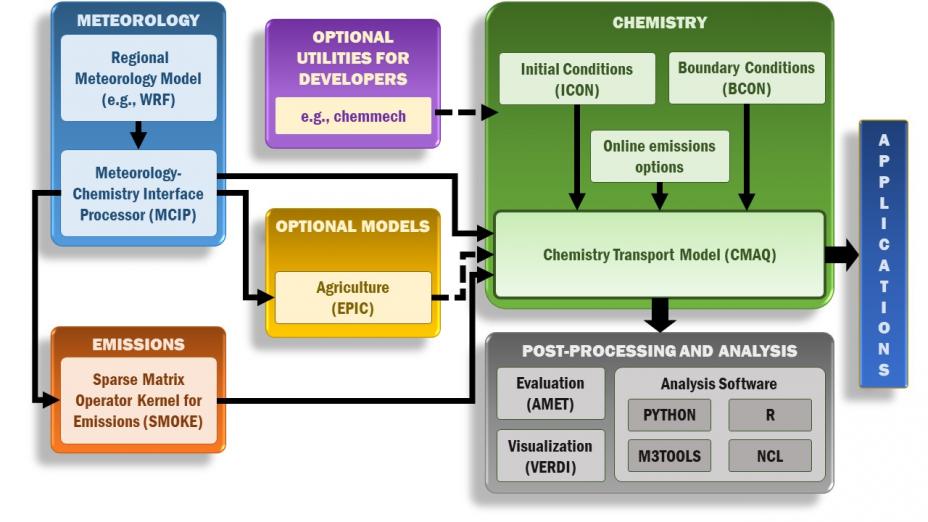CMAQ Models
CMAQ's Purpose
It is important to characterize the exposure of people and ecosystems to pollutants. Measurements are one way of gathering this information, but a more complete picture in space and time is often needed. Air quality models can provide this information for the past, present or future depending on how they are used.
Numerical air quality models simulate the emissions, chemistry and physics of the atmosphere. The Community Multiscale Air Quality (CMAQ) model is a numerical air quality model that relies on scientific first principles![]() first principlesThe fundamental concepts or assumptions on which a theory, system, or method is based. to predict the concentration of airborne gases and particles, and the deposition of these pollutants back to Earth’s surface. Because it includes information about the emissions and properties of compounds and classes of compounds, CMAQ can also inform users about the chemical composition of a mixture of pollutants. This is particularly useful when measurements only give insight into aggregate details, like total particulate mass.
first principlesThe fundamental concepts or assumptions on which a theory, system, or method is based. to predict the concentration of airborne gases and particles, and the deposition of these pollutants back to Earth’s surface. Because it includes information about the emissions and properties of compounds and classes of compounds, CMAQ can also inform users about the chemical composition of a mixture of pollutants. This is particularly useful when measurements only give insight into aggregate details, like total particulate mass.
The purpose of CMAQ is to provide fast, technically sound estimates of ozone, particulates, toxics, and acid deposition. CMAQ is designed to meet the needs of the scientific community and concerned community leaders by combining current knowledge in atmospheric science and air quality modeling, multi-processor computing techniques, and an open-source framework into a single modeling system.
 (Left) Spatial map of ozone monitoring sites in the U.S. with colors indicating the max-8hr ozone concentration. (Right) Spatial map of CMAQ output of max-8hr ozone concentrations.
(Left) Spatial map of ozone monitoring sites in the U.S. with colors indicating the max-8hr ozone concentration. (Right) Spatial map of CMAQ output of max-8hr ozone concentrations.
Capabilities of the CMAQ Model Family
CMAQ allows users to explore different kinds of air pollution scenarios. For example, CMAQ is often used to test the impact of future emission regulations. The interaction of meteorology and air quality, e.g. the effects of particles on solar radiation, can be explored with the two-way WRF-CMAQ system, which couples the Weather Research and Forecasting (WRF) meteorological model with the CMAQ air quality model. The Direct-Decoupled Method (DDM) can be used in CMAQ-DDM to quantify the sensitivity of air pollution predictions to model input values like emissions or reaction rates. Often, people want know more about which individual emission sources or groups of sources are contributing the most to the air pollution at a site. This can be explored using the Integrated Source-Apportionment Method (ISAM) in the CMAQ-ISAM model.
Components of the Modeling System
The CMAQ system is a suite of software programs that work in concert to estimate ozone, particulate matter, toxic compounds, and acid deposition throughout the troposphere. As a framework for simulating the interactions of multiple complex atmospheric processes, CMAQ requires two primary types of inputs: meteorological information, and emission rates from sources of emissions that affect air quality.
Weather conditions such as the changes in temperature, winds, cloud formation, and precipitation rates are the primary physical driving forces in the atmosphere. These conditions are represented in air quality model simulations using output from regional-scale numerical meteorology models, such as WRF. To obtain inputs on emissions, CMAQ relies on the open-source Sparse Matrix Operator Kernel Emissions (SMOKE) model to estimate the magnitude and location of pollution sources.
- Please refer to CMAQ's User's Guide for information on all of the components of the modeling system.

CMAQ History
Since 1998, when the first version was released, CMAQ has been used to evaluate potential air quality policy management decisions. The model provides reliable information for decision makers about the estimated impacts of different air quality policies. CMAQ’s generalized and flexible formulation has enabled incorporation of alternate process algorithms and numerical solution methods. This has allowed inclusion of new science in the model to address increasingly complex air pollution issues.
- Learn about specific model updates and new features available with the most recent model releases.
- Visit Zenodo to see model updates included in past model releases. Exit
Community Based Development
CMAQ incorporates input from a large, world-wide user community. To support the CMAQ user community, EPA and the University of North Carolina at Chapel Hill host the Community Modeling and Analysis System (CMAS) Center, which distributes CMAQ software, hosts user email exchanges, and provides new user training on the CMAQ modeling system.
This growing community, which includes thousands of users in more than 50 countries, has helped assess and improve the model’s functionality. Users include scientists, researchers and air quality modelers, as well as governmental air quality managers who apply the modeling system in their environmental management programs. Their input has helped EPA scientists prioritize modeling research to improve CMAQ’s capabilities.
Visit the CMAS Center.EXIT

